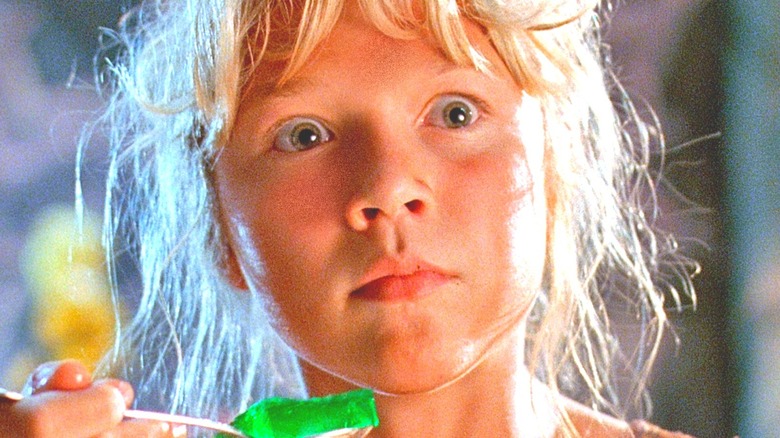The Ending Of Jurassic Park Explained
When "Jurassic Park" first hit theaters in 1993, science fiction fans had no clue what they were in for. It was the first of what would become six "Jurassic Park" movies, with "Jurassic World: Dominion" expected to be released in 2022. The film, directed by Steven Spielberg, was an instant classic and gained immediate recognition from both fans and critics.
For those few who haven't seen it, a group of experts and lawyers, including paleontologist Dr. Alan Grant (Sam Neill), paleobotanist Dr. Ellie Sattler (Laura Dern), lawyer Donald Gennaro (Martin Ferrero), and mathematician Ian Malcolm (Jeff Goldblum), are called in to investigate a Velociraptor attack at "Jurassic Park," a theme park created by industrialist John Hammond (Richard Attenborough). Hammond hopes this team will help validate the safety of the park.
At their arrival, the team is surprised to find real living dinosaurs created by extracting dinosaur DNA from prehistoric mosquitos preserved in amber. They took that and combined it with DNA from frogs to complete the genome. The catch is, by using genetic engineering, all the dinosaurs are female to prevent breeding. The group, along with Hammond's grandchildren, Lex and Tim Murphy (Ariana Richards and Joseph Mazzello), explore the island and find themselves in trouble as the theme park eventually fails.
Now that the newest movie from the franchise is approaching, it's time we go back to the beginning and explain the ending of the first Jurassic Park a little deeper.
The best scene of the movie
Toward the end of the movie, the grandchildren find themselves enjoying some jello alone when they notice both of their jello starts to shake. They realize a dinosaur is nearby, so they scramble into a kitchen to hide.
This is the climax of the movie. The Velociraptors chasing the grandchildren in the kitchen put fear in the hearts of millions. Between the direction, the CGI, and the dramatic silence, it felt as if you were there hiding from the dinosaurs, too. Then you hear it, the screech of the Velociraptors. Fun fact, these noises used for the Velociraptors were made by recording tortoises while they were mating, according to Jurassic Park sound designer Gary Rydstrom (per Vulture). Every detail in this scene puts you at the edge of your seat.
They escape into the park's visitor's center, where they reconnect with Grant and Sattler, but the velociraptors pursue and surround them. The group's demise is inevitable until the unlikely happens. The Tyrannosaurus rex reappears out of nowhere and attacks the smaller dinosaurs, allowing the group to escape. Ironically, the dinosaur that first attacked them ends up saving them, but because fans likely forgot about this predator, it makes for an unexpected yet incredible comeback ending.
Once the massive dinosaur proves it is still at the top of the food chain, a banner falls across the screen that reads, "When dinosaurs ruled the earth." This is an almost literal callback to an early scene in the film that spells out its theme, in which Hammond, while admiring the mosquito preserved in amber, marvels, "Life finds a way." Indeed it has, with the T-rex's violent demonstration of natural selection, and we are left with the presumption that the dinosaurs will once again take over the island.
Small details you might have missed
Earlier in the film, Grant discovers eggshells while hiding with Tim and Lex, which prompts the revelation that the dinosaurs have been mating in the wild. Grant, in another overt extrapolation of the film's "life finds a way theme," explains how the DNA used to fill gaps in the dinosaur's genome comes from frogs that can change their sex in a single-sex environment. Although he clearly wasn't going to lend his endorsement to the park by this point, this revelation further sealed the deal. But it also nodded to another of the film's thematic implications, as outlined early in the film by Malcolm, who warned against the myriad unknowns of genetic engineering.
If you remember, at the beginning of the film, Malcolm explains to Dr. Sattler the chaos theory, claiming small changes in complex systems can have unpredictable effects. This is also known as the butterfly effect. Changing something that isn't supposed to be altered can have enormous consequences. Malcolm warns that the amusement park would quickly decline because of the idea, and he couldn't have been more right. By the end of the film, it's clear that humans shouldn't be playing with any old genetics, and the entire island falls back to the hands of the dinosaurs.


